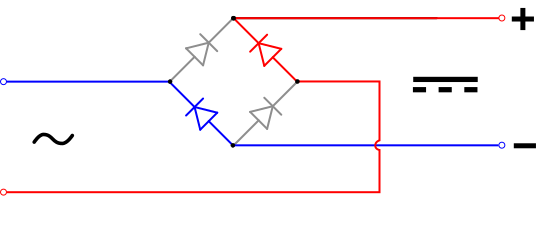To understand Bridge Diode
The explanations of Bridge Diode found on the net are more or less the same. But I wonder how many common people understand. Before seeing the Bridge Diode function we see Center Tap (Transformer) type full wave rectifier, where two diode are used with a transformer.
Center Tap (Transformer) - Wiki
:
:
Common applications of center-tapped transformers
The above is the typical rectifier circuit by using center-tapped transformer.
Bridge Diode
Wiki
wiki
In the diagrams below, when the input connected to the left corner of the diamond is positive, and the input connected to the right corner is negative, current flows from the upper supply terminal to the right along the red (positive) path to the output and returns to the lower supply terminal through the blue (negative) path.
sptt
This explanation is misleading or even incorrect. The incorrect part is
the input connected to the right corner is
negative,
This should be < still positive but lesser voltage than the left corner of the
diamond (which is positive). The current still flows.
Please consider the polarity of diode.

The input polarity changes + / - cyclically or sinusoidally.
the input connected to the left corner of the diamond is the voltage change 0 -> + peak -> 0
and then -> - peak -> 0 with time (periodically).
When the input connected to the left corner is negative, and the input connected to the right corner is positive, current flows from the lower supply terminal to the right along the red (positive) path to the output and returns to the upper supply terminal through the blue (negative) path.
Again this is incorrect. The incorrect part is
(the) current flows from the
lower supply terminal to the right along the red (positive) path to the
output and returns to the upper supply terminal through the blue
(negative) path
the blue
(negative) path
Then you can get the full wave rectification shown above.
How does a bridge rectifier work?
Since current can only flow in one direction through a diode, current must travel different paths through the diode bridge depending on the polarity of the input. In either case, the polarity of the output remains the same. When there is an AC input, the current travels one path during the positive half cycle, and the other during the negative half cycle. This creates a pulsating DC output since the signal still varies in magnitude, but no longer in direction.

Current flow in a bridge rectifier during the positive half cycle.

Current flow in a bridge rectifier during the negative half cycle.


No comments:
Post a Comment